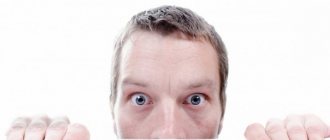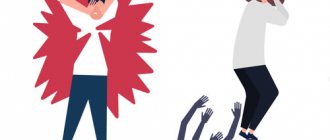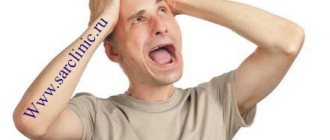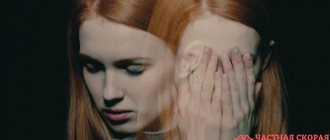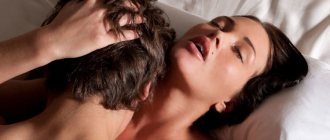Today, many people suffer from attacks of unreasonable panic fear. It can occur suddenly - in the subway, at home, among a crowd of people or completely alone, early in the morning or late at night. Such attacks are called “panic attack” or “vegetative crisis”. In fact, panic attacks and their symptoms are quite diverse, and can manifest differently in different people.
As a rule, at first there is a slight uneasy feeling. Anxiety increases in a matter of minutes - from fear a person cannot move: get up, go outside, go to work. The heart beats faster, the hands sweat, dizziness, headache, nausea, tremors occur, and the arms or legs may even become numb. It seems to a person that he is about to lose consciousness, go crazy, or even die from a heart attack or stroke, and therefore he is afraid to move, so as not to fall in front of many people or, conversely, to be left without help. And so, he can wait for 30-60 minutes until the attack of fear subsides.
“One day I was tinkering with my car in the garage as usual. Suddenly, out of the blue, I felt numbness on the left side of my face and body. I couldn't move, it was like I was paralyzed. At the same time, I began to feel very thirsty - my throat was dry. I felt hot and cold, and I just lay down in the car and waited for it to end. After 30 minutes I was released. From then on, as soon as I approached the car, I felt bad, and if I got behind the wheel, everything swam before my eyes. In the end, I even had to quit my job as a car mechanic,” patient Arthur (46 years old).
It also happens that a person who suddenly has a panic attack, on the contrary, runs as quickly as possible into fresh air because he experiences an acute feeling of suffocation - and this helps him cope with the attack.
Some patients complain that they begin to experience anxiety when faced with a specific situation. For example, when you need to drive or go to work. If a person continues an action that irritates his nervous system, the intensity of the attack increases. If he stops the action and returns home, then the anxiety gradually fades away. Thus, many people who suffer from panic attacks and their symptoms have to quit work, study, and completely change their usual lifestyle. And this method also often helps them to significantly reduce the manifestations of panic disorder, but not get rid of it completely. In addition, not everyone can afford such drastic changes in life.
What to do if you experience regular attacks of panic?
Panic attack symptoms
People with panic disorder very often do not see a doctor for a long time and do not tell their loved ones about the existing problem. As a rule, a person either thinks that there is no problem, and he himself will be able to cope with his poor health, forcibly overcoming all the signs of a panic attack, or he is embarrassed by his “weakness,” or is completely afraid that he will be “sent to a mental hospital.” This is completely unnecessary. However, it is necessary to treat sudden and regular panic fear.
“When I first had a panic attack, I had to call an ambulance. They just gave me glycine and didn't tell me anything else. After that, I went through the entire cardiology center and passed all the tests. I was told that I was absolutely healthy. My family and friends thought I was faking it. I tried not to pay attention to the attacks, reassuring myself that when I came home everything would be fine. Sometimes he deliberately drove himself into a traffic jam in order to overcome his fear. Such a nightmare was happening that you could at least abandon the car and leave. Sometimes I did just that. I would drop my car off at the metro station and come and pick it up the next day. Although before this illness I generally tolerated traffic jams calmly,” patient Pavel (41 years old).
First, let’s look at the symptoms with which you can probably come to the doctor and say: “Doctor, I’m having panic attacks. What to do?"
Psycho-emotional component of a panic attack. Symptoms and signs:
- Sudden, unreasonable attacks of fear/anxiety/panic, lasting from several minutes to several hours
- Waiting for sudden death, waiting for an attack
- Intrusive thoughts (usually related to death)
— Blurred consciousness
- Feeling of derealization (“I am separate, the world is separate”, “the world through cellophane”, “like in an aquarium”)
- Constant feeling of anxiety
— Various phobias (agoraphobia, social phobia, etc.)
— Insomnia, “nightmare” dreams
— Decreased mood, tearfulness
- Irritability, aggressiveness
“In the summer of 2014, I realized that I regularly could not fall asleep until 5-6 o’clock in the morning. The stuffy summer aggravated my condition, I constantly experienced a feeling of lack of air, my heartbeat quickened, obsessive thoughts arose in my head: “What if I’m dying?” - panic grew, but I had no strength to move or call an ambulance. I lay there like that until the morning, when my eyes closed on their own from fatigue and constant tension. This happened several times a week,” patient Elena (28 years old, manager).
Physiological component of a panic attack. Symptoms and signs:
— Dizziness, headache, heaviness in the head, noise in the head/tinnitus
- Lack of air, suffocation, shortness of breath
— Rapid heartbeat, feeling of interruptions in the heart, pain in the heart
- Nausea, abdominal discomfort
- Chills, fever, sweating
- Trembling in the arms, legs, body
- Muscle tension, numbness in limbs
— Gastrointestinal tract disorder
- Feeling tired, weak, lack of strength
“5 years ago I was unsuccessfully treated with antibiotics and after that I started having stomach problems. All these years I suffered from constant diarrhea. I contacted a parasitologist, gastroenterologist, immunologist and other specialists. Tests and clinical studies did not reveal any diseases. I tried to be treated with probiotics and prebiotics, but to no avail. Other symptoms also began to bother me: heaviness in the head, tension in the back and neck, anxiety for no reason, fear for one’s health, sometimes the heart was pounding wildly, in the morning after sleep there was slight dizziness and, of course, constant fatigue and weakness,” patient, Andrey (31 years old).
Important symptoms of panic attacks are also their systematicity and regularity. The interval between panic attacks can vary from a few minutes to several days or months, but their regular occurrence indicates that you are suffering from a panic disorder.
Clinical manifestations
A panic attack is characterized by an attack of sudden, intense fear or discomfort accompanied by at least 4 of the 13 symptoms (see Table 1 below). Symptoms of panic usually develop within 10 minutes and quickly self-limit, leaving the doctor no opportunity for observation. Panic attacks are not medically life-threatening.
Symptoms of a panic attack
| Table 1 |
| Cognitive |
| - Fear of death - Fear of going crazy or losing control of behavior - Feelings of unreality, strangeness (derealization) or alienation from oneself (depersonalization) |
| Somatic |
| — Pain or discomfort in the chest — Dizziness, — Unsteadiness of feelings, malaise — Feeling of suffocation — Hot flashes, chills — Nausea, stomach upset — Numbness, tingling in the extremities — Palpitations, accelerated heart rate — Feelings of shortness of breath, suffocation — Increased sweating — Trembling, local tremor |
Panic attacks can occur in any alarming situation related to the underlying cause of the disorder (for example, a person with a phobia of snakes may panic at the sight of a snake). These panic attacks are called “expected” panic attacks. “Unexpected” are those panic attacks that occur spontaneously, without any apparent reason.
Most people with panic disorder anticipate another attack and avoid places or situations in which they previously panicked. People with panic disorder often worry that they have dangerous heart, lung, brain, or other disorders, and they repeatedly visit their family doctor or go to the emergency room for help. Unfortunately, in these settings, attention is often focused on general medical symptoms and a correct diagnosis is not made.
Many people with panic disorder also have symptoms of severe depression.
Panic attack. Emergency self-help.
First, learn how to manage your panic attacks yourself to control them and reduce the intensity of your panic attack symptoms.
Try practicing breathing techniques.
Breathe through your diaphragm (belly), in through your nose and out through your mouth slowly and calmly. For example, for 5 counts – inhale, for 10 – exhale.
“Some patients benefit from progressive muscle relaxation. If your muscles are very tense during a panic attack, try tightening your facial muscles: tense your jaw for 8 seconds - then relax, tense your lips for 8 seconds - relax. Repeat the exercise with your arms (palms, forearms) and switch to the next muscle group, for example, the calf muscles, the feet. Alternate tension and relaxation of all parts of the body will help relax the muscles and distract thoughts,” recommendations of a neurologist-vegetologist (“Clinical Center for Autonomic Neurology”).
During a panic attack, try to distract yourself and not think about the symptoms that are bothering you. Use psychological techniques. Visualize some place where you felt good: a house, a vacation spot, a cottage, a forest, a sandy beach - whatever your heart desires. And imagine in detail the entire environment that surrounds you there: a soft chair, a fluffy cat, the smell of pine trees, the crunch of branches under your feet, birdsong, warm sand, etc. Think in advance about where it would be better for you to “go” when you have another panic attack in order to distract your thoughts from its symptoms.
Keep a diary of panic attacks that you can refer to in critical situations. This way you can remind yourself that there is nothing to be afraid of, and the next panic attack will soon pass.
Panic attacks. Difficulties in diagnosis.
People suffering from the symptoms of panic attacks usually do not know where to turn. They visit the offices of a therapist, cardiologist, endocrinologist, psychiatrist, psychologist, but doctors do not detect any disturbances in the functioning of the body. Of course, it is advisable to undergo all possible examinations and pass all the necessary tests in order to exclude the development of serious physiological abnormalities. However, if, in the end, they tell you that you are absolutely healthy, but anxiety, tachycardia, insomnia and other symptoms continue to torment you, then most likely you suffer from panic disorder, which means the problem lies in a disruption of the autonomic nervous system , which can only be identified by an experienced neurologist-vegetologist.
Some patients with signs of panic attacks are diagnosed with vegetative-vascular dystonia (VSD) and told that they will have to live with such symptoms all their lives, alleviating them with medications: antidepressants and tranquilizers.
“I went to all the doctors because there were a lot of symptoms: my heart, shortness of breath, blood pressure, my stomach, bones, muscles ached, I felt constant anxiety. At first, rare panic attacks grew into a daily norm. The neurologist prescribed Coaxil, but the pills made me feel worse. I drank Coaxil for three months and barely got off it. Then the therapist prescribed me adaptol. It made me feel better, but only while I was drinking it, and as soon as I stopped drinking, everything started all over again. Everything was useless until I learned from friends about the “Clinical Center for Autonomic Neurology”,” patient, Arthur (46 years old).
The deep misconception that VSD and panic attacks cannot be treated can be dispelled if you visit a doctor who specializes specifically in disorders of the autonomic nervous system. Panic attacks can be treated and diagnosed! The main thing is to know where and how this can be done.
Time frame for panic attack treatment
In this case, we indicate the duration of therapy approximately, based on the majority of cases we observe. Supervision of outpatient programs is designed for 1.5 months. In this case, the patient must attend sessions at least 2-3 times every week. This is followed by a clinical observation phase lasting from 6 to 9 months. During this period, the patient can consult a specialist at any time if there is a suspicion of a relapse.
Advantages of the method and its effectiveness
Timely seeking help gives a high chance of completely curing the patient and putting him into a state of stable remission. At the same time, the effectiveness of conventional therapy in other medical institutions is only 20-30%. The effectiveness of therapy at the Transfiguration clinic reaches up to 95%. Treatment is carried out according to our proprietary methods. The methods have been developed at the clinic since 1990 and continue to be improved and supplemented based on scientific developments. In the most severe cases - 70-80%. In this case, only those cases in which we observed complete recovery were taken into account, taking into account follow-up for more than 5 years. At the same time, completely ineffective cases of treating panic attacks using our methods have not been observed for more than 15 years. Insufficient effect is considered to be an incompletely cured disorder, which in 90% of cases is justified directly by the disease itself and 10% by a violation of the regime. The productivity of the program is achieved thanks to the experience of our specialists and a combination of psychotherapy, physiotherapy, psychopharmacotherapy, as well as other additional techniques.
Panic attacks. Modern diagnostic methods.
Only a qualified neurologist-vegetologist can diagnose panic disorder, which manifests itself as panic attacks, identify its symptoms and prescribe optimal treatment.
At the initial examination, the vegetarian doctor must examine the patient’s normal reflexes, his muscular system, sensory organs, cognitive functions (memory, speech, perception), assess the general psycho-emotional state of the patient, taking into account all his complaints in order to collect a complete picture of the disease.
Next, there are several methods for diagnosing autonomic nervous disorder. One of them is the study of heart rate variability.
The patient performs a simple load: first he lies on his back, and after a few minutes he gets to his feet. In this way, we simulate a standard everyday situation when the minimum load is placed on our body. During this time, sensors attached to the patient's chest record the rhythm of his heart, and the doctor then compares the changes in rhythm in both positions. Such a study shows how adapted the human body is to the usual minimum load, which our autonomic nervous system normally copes with every day without the slightest difficulty.
How it works?
In a healthy state, our body responds adequately to any “stress”, any load (mental, physical, emotional). Therefore, when a healthy person gets up, the sympathetic part of the autonomic nervous system is activated in his body and the hormone adrenaline is produced, which means the heartbeat quickens. When a person lies down, his body should normally be in the mood for rest and relaxation. At the physiological level, this manifests itself as follows: the parasympathetic department of the autonomic nervous system becomes active and the hormone acetylcholine is released, which extinguishes the activity of adrenaline, and a phase of relaxation and replenishment of the body’s reserves begins.
But in patients with symptoms of panic attacks, an abnormal change in heart rhythms is observed: that is, when a person lies down, his pulse quickens and becomes faster and faster. That is, when a person gives his body the command to tune in to rest, the body understands the opposite - and prepares to run a short distance race. This is why people with disorders of the autonomic nervous system so often cannot sleep at night and never feel rested and alert.
Thus, the doctor concludes that the harmonious functioning of the sympathetic and parasympathetic parts of the nervous system is disrupted. This means you can move on to the next stage of the examination.
Among the innovative methods for diagnosing panic disorder are studies of the autonomic nervous system using infrared thermography. In an infrared image, a thermal imager clearly shows in which nodes (ganglia) of the autonomic nervous system the work is disrupted. It is with these vegetative nodes that the neurologist-vegetologist will subsequently work.
“Serious scientific research over the last decade has shown the high reliability and reliability of thermography. This allows this method to be used in medical practice to make a diagnosis in complex cases,” James Mercer, Professor, President of the European Thermography Society (EAT).
| Fig. 1 – Thermal image before treatment of panic attacks and VSD – the functioning of the vegetative node in the cervical region is disrupted (colors – red and orange) | Fig. 2 - Thermal image of the same patient after treatment of panic attacks and VSD - the temperature in the vegetative node of the cervical spine has returned to normal (colors - blue and green) |
After treatment, you can take a repeat infrared photo, in which you will notice progress from the completed course. Areas with abnormal temperatures (bright red or dark blue) will change color in the image because their temperature regime is closer to normal.
Psychotherapy used for panic attacks
- rational therapy,
- positive,
- behavioral,
- problem crystallization method,
- phototherapy,
- transactional analysis,
- hypnotherapy.
Main stages of psychotherapy
- Didactic. Understanding the logic of the disease and choosing the appropriate treatment strategy.
- Cognitive. The second stage is aimed at identifying maladaptive thoughts of a so-called automatic nature, which support feelings of disappointment, apathy, and depression.
- Behavioral. The goal of the third stage is to introduce into the patient’s consciousness a strategy that promotes the emergence of a sense of self-esteem (respect for oneself as an individual) and positive life motivation.
Biotherapy
In case of severe panic attacks or complications, our specialists resort to drug therapy. This is mainly a special neuromebabolic therapy aimed at relieving acute attacks and restoring metabolic processes in the brain. This therapy not only helps to stop attacks, but also nourishes and restores the structure of neural connections. In the case of the vestibular form, neurometabolic stimulants, which have a sedative effect, are added to the treatment regimen. All drugs used in the Preobrazhenie clinic do not cause dependence (addiction), are completely safe and are recommended for use by leading scientific and practical institutes of the world.
Additional procedures may be prescribed to enhance the effect of treatment.
Physiotherapy
The methodology includes the following areas:
- color therapy;
- MDM therapy;
- aromatherapy with oils that have a calming effect;
- Lenarotherapy and electrosleep.
Massage and exercise therapy
Light massage is also used as an additional treatment method, especially in the neck area. At the initial stage of the program, exercises are performed aimed at general relaxation of the body, as well as breathing exercises that help level out anxiety symptoms. At the next stage, it is necessary to perform general strengthening gymnastics. Exercises should be moderate and regular, since uneven distribution of physical stress and excessive stress can cause a deterioration in the patient's condition. When performed, the greatest blood flow should be provided to those parts of the body that suffer the most as a result of the attacks.
Phytotherapy
Treatment of panic attacks with herbal medicine is ineffective and this method can be used as an additional, supportive therapy in parallel with the main one. For this type of therapy, decoctions of nettle, lemon balm, common valerian, oregano, sweet clover, watch, St. John's wort, primrose, speedwell, linden, strawberry, calendula, wormwood, lily of the valley, mordovnik, black nightshade, mint, motherwort, as well as a sedative collection are used.
Diet therapy
Nutritionists for such disorders recommend sticking to table No. 12. The following foods should be excluded from the patient’s diet:
- onion and garlic;
- confectionery;
- fatty meat broths;
- smoked meat products;
- cucumbers;
- alcoholic drinks;
- coffee and strong tea.
Some restrictions are imposed on the consumption of meat products and salt. Patients should consume legumes and dairy products, as well as iron-rich meats. Substances that help reduce stress levels are also found in fish and other seafood.
Panic attacks symptoms and treatment
To successfully treat panic attacks, an integrated approach is required; one of the modern treatment methods is complex physiotherapy. The treatment is aimed at the root cause of the disorder, which is rooted in the physiological disruption of the body. Psychotherapy can also be used as a method of treating panic attacks, but only as an auxiliary link. In some cases, a psychotherapist can alleviate the condition and reduce the severity of panic neurosis.
One of the clinics in Moscow that specializes directly in disorders of the autonomic nervous system is the Clinical Center for Autonomic Neurology. The clinic’s doctors have extensive experience working with panic attacks: they know how their symptoms manifest themselves and what treatment will be optimal in a given case. As part of a comprehensive physiotherapy course, you can be offered:
— undergo a course of intravenous laser therapy
— infrared laser therapy
— magnetic therapy
— as well as a course of color pulse correction of suprasegmental autonomic disorders (color therapy)
All methods are aimed at working directly with damaged vegetative nodes.
The targeted effect on the nerve nodes in its effect on the body is reminiscent of acupuncture in oriental medicine (acupuncture), but the action of the laser is much more accurate and is based on science, and not on ancient intuitions, especially since it is supported by thermal imaging images that show the localization of the vegetative node in the human body accurate to the millimeter.
“I underwent 2 courses of acupuncture with symptoms of panic attacks. After the first course, which lasted a month, I felt better - I just sighed. But a month later I had to return. Another month after the second course, my body completely returned to its previous deplorable state. The effect faded away again. Acupuncture gave me only temporary relief. The effect of the laser was incomparably more effective,” patient Alexander (43 years old).
For most patients, it is enough to undergo one course of comprehensive physical therapy to feel significantly better, and after a recovery period that lasts from 4 to 6 months, to completely get rid of all symptoms of panic attacks. In more advanced cases, several courses may be required. However, noticeable improvements are noticeable after the first treatment session.
“During laser therapy sessions, I felt relaxed and even fell asleep. After the first sessions, the anxiety noticeably subsided and my head cleared. Panic attacks after completing the course of treatment became rare and short-lived. There was one case of exacerbation in the subway, but the doctor warned me that this was possible during the recovery period. I happily completed the second course of treatment a year later and now I feel even better than when I didn’t have panic attacks yet,” patient Sergei (34 years old).
Treatment of panic attacks (panic disorder)
After the first manifestation of PA, a person visits a therapist, neurologist, cardiologist - specialists do not detect the disorder. A patient sees a psychotherapist when he or she becomes depressed. Initially it was necessary to visit it. The specialist will tell you what is happening to the patient, talk about the characteristics of the disease, and select treatment methods.
The main goal of treating panic attacks (panic disorder) is to reduce the number of attacks and alleviate symptoms. Treatment is psychological and medicinal. The direction is chosen depending on individual characteristics.
Treatment of panic attacks in Moscow is carried out at the address: Moscow, st. Gabrichevsky, 5, room 10. Our psychiatry clinic is located within walking distance from the Shchukinskaya metro station. Tel.: 8 (495) 664-40-40.
Psychotherapy
The ideal option to start treatment is a conversation with a psychotherapist. He will look at the problem from a professional point of view and identify the cause of its occurrence. Will select the optimal treatment option. The specialist uses psychotherapy techniques:
- Cognitive-behavioural. The most common method of treating seizure attacks. It includes several steps, the purpose of which is to change the patient’s thinking and attitude towards the situation.
- Neurolinguistic programming. A special type of conversation is used, the person looks for terrible situations and experiences them. Having gone through the situation several times, he forgets and the fear disappears.
- Gestalt therapy. A more modern approach. The person analyzes in detail the circumstances that cause anxiety. During the treatment period, a specialist helps to find solutions and methods of getting rid of a panic attack.
- Hypnosis. In a state of trance, the patient is given instructions to get rid of PA. The technique is not suitable for everyone.
- Body-oriented. Methods of working with bodily influence to reduce the level of anxiety. These are relaxation methods and breathing exercises.
Modern family psychotherapy includes techniques that look at the symptoms of attacks from the family's point of view. A state of panic is interpreted not as an illness of one family member, but as disharmony in family relationships.
Medications to treat panic attacks
The duration of the course is at least 6 months. The drug is completely discontinued if a panic attack does not occur within 1 month. The doctor prescribes the following medications to treat a panic attack:
- sedatives;
- tranquilizers;
- antidepressants;
- neuroliptics;
- nootropics.
Only a doctor can prescribe pills! It is not recommended to use them on your own.
The first group is sedatives. They act effectively at the initial stage of the disease. Made from plant materials. These are Valerian, Corvalol, Persen. There are few active ingredients in the drugs, so they are sold without a prescription. Their independent use is allowed. The result is a decrease in the level of anxiety, irritability, normalization of sleep, and a decrease in heart rate. Tranquilizers have the following effects:
- relieve anxiety;
- calm down;
- relieve cramps;
- help you fall asleep;
- relax.
The drugs differ in their addictive effect.
Course – maximum 2 weeks. Dispensed with a doctor's prescription. The more common ones are Noozepam, Atarax, Afobazol. According to the duration of action, there are short-acting (up to 6 hours), medium-acting (up to 24 hours) and long-acting (up to two days).
Regular PA causes depression, so antidepressants are used in treatment. The brain begins to work as usual. Emotional stability will be restored, excitability will decrease, anxiety will disappear, and your mood will improve.
At first, the doctor will prescribe a small dose, gradually increase it and reduce it again until it is completely stopped. Duration of treatment is six months to a year. There is no addiction to the drugs, but there are side effects - dizziness, pain, fatigue, weakness, insomnia. Effective antidepressants - Remeron, Plizil.
Antipsychotics are used as adjunctive therapy rather than primary medication. These are sedatives that reduce reactions to external stimuli, eliminating agitation and aggression. This is Sonapax, Thiokril. They have no hypnotic effect. It is not recommended to use them for a long time - the endocrine system will be disrupted.
The last group is nootropics. Prescribed in combination with other drugs. They suppress anxiety, stabilize the activity of the nervous system, improve memory, and help cope with fears. The most popular is Glycine.
Treating panic attacks yourself at home
It is possible to treat panic attacks yourself at home. If anxiety states occur frequently, physical exercise will help. They will relieve stress, give confidence, and help you calm down. You must do:
- Stretching. They lean forward, keep their legs straight, and try to touch their feet with their fingertips. When performing the exercise, the body is saturated with oxygen.
- "Tree". The legs are placed wider, the arms are extended upward. Lean from one side to the other. Perform slowly, without making sudden movements. Exercise will reduce muscle tension.
- "Cat". Sit on the floor, tuck your legs under you. The arms are extended upward, slowly lean forward and touch the floor. The back muscles should be relaxed.
- "Eagle". Sit on the floor and cross your legs. As you inhale, slowly raise your arms up, and as you exhale, lower them. The movements will lower your pulse, normalize your breathing, and relieve fatigue.
- Meditation. The room should be quiet, phones should be turned off. Lie on your back, place your hands on the floor and close your eyes. You need to feel your own body, concentrate on its individual parts, and relax.
- Correct breathing. It should be smooth and deep. When anxiety arises, try to normalize it. Exhale through the nose, inhale through the mouth.
Taking a bath with medicinal herbs will have a positive effect. Take them no more than 10 days in a row, before bedtime. Water temperature – no more than 37°, duration – 15 minutes. Melissa and pine needles are added to the water. An artificial improvement in mood - a smile - can cope with attacks.
You can cope with your own efforts in this way:
- soak your feet in hot water;
- pour cold and hot water over your feet up to your knees;
- breathe into a paper bag;
- take herbal decoctions.
To achieve results, you need to face fear head on. If a person has a fear of crowds, you need to go to a place with a large crowd of people - stand and understand that there is no threat. Fear will disappear.
The use of herbal preparations
If a person does not require hospitalization, treatment of VSD and panic attacks is carried out using herbal preparations. Folk remedies have a sedative effect and have a positive effect on the heart and nervous system. There are no side effects, there is no addiction. The goal of traditional therapy is to calm the nervous system, improve sleep, and strengthen the cardiac system.
With PA, a person becomes irritable and aggressive. Against the backdrop of an accumulation of unpleasant sensations, panic appears. The best natural remedy for relieving symptoms is mint, lemon balm, valerian, motherwort. Use as a decoction or simply add to tea.
Grind the motherwort root, pour in 100 ml of chilled boiled water and squeeze. Take the juice 25 drops 4 times a day. To relieve fatigue, make a decoction of valerian - 20 g of herb, pour 0.5 liters of water, cook over low heat for 8 minutes.
With PA, sleep is disturbed. Linden decoction will relieve insomnia. Fruits or young leaves are used. 5 g of crushed leaves are poured into 150 ml of boiled water and left for half an hour. You can add 1 tsp. honey Take for 10 days. An alcoholic infusion of oregano will improve sleep - 10 g of the herb is poured into 150 ml of alcohol and infused. Take 25 drops before bedtime.
A panic attack is accompanied by pain in the heart - the patient develops a fear of death. A person experiences a lack of oxygen and suffers from suffocation. To strengthen the cardiac system, use rose hips and hawthorn. Drink freshly squeezed juice before bed.
Other herbal teas:
- Tansy, calendula, oregano. Take 1 tsp. ingredients, mix, pour 360 ml of boiling water. Leave for 3 hours. Take half a glass three times a day. The effect will occur on the 3rd day.
- Mint, oregano, valerian, sweet clover. Take 5 tsp. sweet clover and oregano, 2 l. mint leaves, 3 l. valerian roots. Pour 0.5 liters of boiling water, leave under the lid for 2 hours. Strain. Drink a decoction of 0.5 tbsp. 3 times a day. PA will be stopped, symptoms of VSD will disappear.
- Hawthorn, motherwort, cudweed, chamomile. Take 2 tablespoons of herbs, mix, pour 180 ml of boiling water, leave for 4 hours. Strain, take after meals three times a day.
- Cumin, valerian, chamomile. 1 tsp. caraway seeds are mixed with 3 tsp. chamomile, 2 tsp. valerian. Mix the herbs, pour in 360 ml of boiled water, leave for half an hour, filter. The decoction relieves anxiety and fear. Drink half a glass in the morning and before bed.
Some herbs are poisonous and taking them incorrectly will cause side effects. Before starting treatment with folk remedies, it is necessary to exclude the possibility of allergies and consult a specialist.

